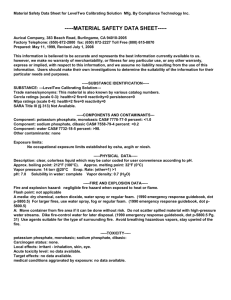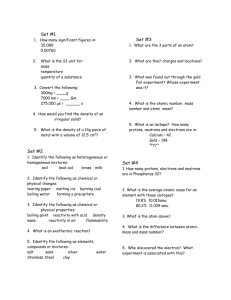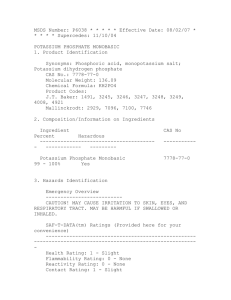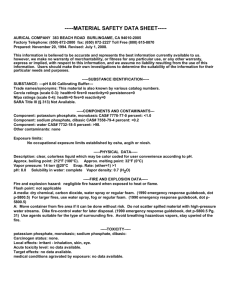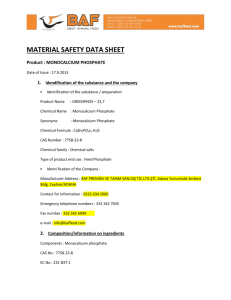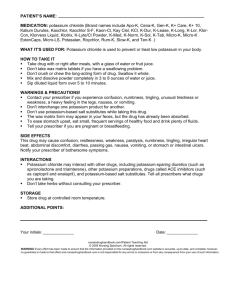Potassium Phosphates Injection 1. CHEMICAL PRODUCT
advertisement
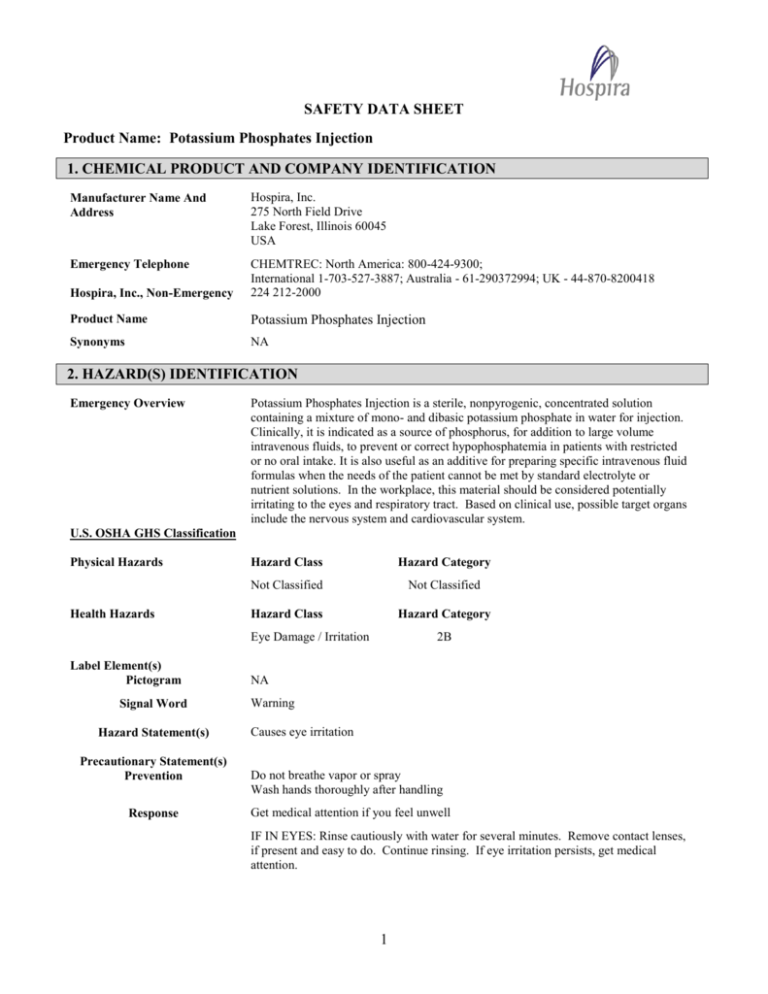
SAFETY DATA SHEET Product Name: Potassium Phosphates Injection 1. CHEMICAL PRODUCT AND COMPANY IDENTIFICATION Manufacturer Name And Address Hospira, Inc. 275 North Field Drive Lake Forest, Illinois 60045 USA Emergency Telephone Hospira, Inc., Non-Emergency CHEMTREC: North America: 800-424-9300; International 1-703-527-3887; Australia - 61-290372994; UK - 44-870-8200418 224 212-2000 Product Name Potassium Phosphates Injection Synonyms NA 2. HAZARD(S) IDENTIFICATION Emergency Overview Potassium Phosphates Injection is a sterile, nonpyrogenic, concentrated solution containing a mixture of mono- and dibasic potassium phosphate in water for injection. Clinically, it is indicated as a source of phosphorus, for addition to large volume intravenous fluids, to prevent or correct hypophosphatemia in patients with restricted or no oral intake. It is also useful as an additive for preparing specific intravenous fluid formulas when the needs of the patient cannot be met by standard electrolyte or nutrient solutions. In the workplace, this material should be considered potentially irritating to the eyes and respiratory tract. Based on clinical use, possible target organs include the nervous system and cardiovascular system. U.S. OSHA GHS Classification Physical Hazards Health Hazards Hazard Class Hazard Category Not Classified Not Classified Hazard Class Hazard Category Eye Damage / Irritation Label Element(s) Pictogram Signal Word Hazard Statement(s) Precautionary Statement(s) Prevention Response 2B NA Warning Causes eye irritation Do not breathe vapor or spray Wash hands thoroughly after handling Get medical attention if you feel unwell IF IN EYES: Rinse cautiously with water for several minutes. Remove contact lenses, if present and easy to do. Continue rinsing. If eye irritation persists, get medical attention. 1 Product Name: Potassium Phosphates Injection 3. COMPOSITION/INFORMATION ON INGREDIENTS Active Ingredients Names Chemical Formula Monobasic Potassium Phosphate KH2PO4 Component Monobasic Potassium Phosphate, Anhydrous Dibasic Potassium Phosphate, Anhydrous Approximate Percent by Weight 22.4 23.6 Dibasic Potassium Phosphate, K2HPO4 CAS Number RTECS Number 7778-77-0 7758-11-4 TC6615500 TC5580000 Non-hazardous ingredients include Water for Injection. 4. FIRST AID MEASURES Eye Contact Remove from source of exposure. Flush with copious amounts of water. If irritation persists or signs of toxicity occur, seek medical attention. Provide symptomatic/ supportive care as necessary. Skin Contact Remove from source of exposure. Flush with copious amounts of water. If irritation persists or signs of toxicity occur, seek medical attention. Provide symptomatic/supportive care as necessary. Inhalation Remove from source of exposure. If signs of toxicity occur, seek medical attention. Provide symptomatic/supportive care as necessary. Ingestion Remove from source of exposure. If signs of toxicity occur, seek medical attention. Provide symptomatic/supportive care as necessary. 5. FIRE FIGHTING MEASURES Flammability None anticipated for this aqueous product. Fire & Explosion Hazard None anticipated for this aqueous product. Extinguishing Media As with any fire, use extinguishing media appropriate for primary cause of fire such as carbon dioxide, dry chemical extinguishing powder or foam. Special Fire Fighting Procedures No special provisions required beyond normal firefighting equipment such as flame and chemical resistant clothing and self contained breathing apparatus. 6. ACCIDENTAL RELEASE MEASURES Spill Cleanup and Disposal Isolate area around spill. Put on suitable protective clothing and equipment as specified by site spill control procedures. Absorb the liquid with suitable material and clean affected area with soap and water. Dispose of spill materials according to the applicable federal, state, or local regulations. 7. HANDLING AND STORAGE Handling No special handling required under conditions of normal product use. Storage No special storage required for hazard control. For product protection, follow storage recommendations noted on the product case label, the primary container label, or the product insert. Special Precautions No special precautions required for hazard control. 2 Product Name: Potassium Phosphates Injection 8. EXPOSURE CONTROLS/PERSONAL PROTECTION Exposure Guidelines Exposure Limits Component OSHA-PEL ACGIH-TLV AIHA WEEL Monobasic Potassium 8-hr TWA: Not 8-hr TWA: Not 8-hr TWA: Not Phosphate, Anhydrous Established Established Established Dibasic Potassium Phosphate, 8-hr TWA: Not 8-hr TWA: Not 8-hr TWA: Not Anhydrous. Established Established Established Notes: OSHA PEL: US Occupational Safety and Health Administration – Permissible Exposure Limit Hospira EEL 8-hr TWA: Not Established 8-hr TWA: Not Established ACGIH TLV: American Conference of Governmental Industrial Hygienists – Threshold Limit Value. AIHA WEEL: Workplace Environmental Exposure Level EEL: Employee Exposure Limit. TWA: 8-hour Time Weighted Average. Respiratory Protection Respiratory protection is normally not needed during intended product use. However, if the generation of aerosols is likely, and engineering controls are not considered adequate to control potential airborne exposures, the use of an approved air-purifying respirator with a HEPA cartridge (N95 or equivalent) is recommended under conditions where airborne aerosol concentrations are not expected to be excessive. For uncontrolled release events, or if exposure levels are not known, provide respirators that offer a high protection factor such as a powered air purifying respirator or supplied air. A respiratory protection program that meets OSHA's 29 CFR 1910.134 and ANSI Z88.2 requirements must be followed whenever workplace conditions require respirator use. Personnel who wear respirators should be fit tested and approved for respirator use as required. Skin Protection If skin contact with the product formulation is likely, the use of latex or nitrile gloves is recommended. Eye Protection Eye protection is normally not required during intended product use. However, if eye contact is likely to occur, the use of chemical safety goggles (as a minimum) is recommended. Engineering Controls Engineering controls are normally not needed during the normal use of this product. 9. PHYSICAL/CHEMICAL PROPERTIES Appearance/Physical State Odor Odor Threshold pH Melting point/Freezing Point Initial Boiling Point/Boiling Point Range Flash Point Evaporation Rate Flammability (solid, gas) Upper/Lower Flammability or Explosive Limits Vapor Pressure Vapor Density (Air =1) Relative Density Solubility Partition Coefficient: n-octanol/water Auto-ignition Temperature Decomposition Temperature Viscosity A sterile, nonpyrogenic, concentrated solution NA NA NA NA NA NA NA NA NA NA NA NA NA NA NA NA NA 3 Product Name: Potassium Phosphates Injection 10. STABILITY AND REACTIVITY Reactivity Not determined. Chemical Stability Stable under standard use and storage conditions. Hazardous Reactions Not determined Conditions to Avoid Not determined Incompatibilities Not determined Hazardous Decomposition Products Not determined. During thermal decomposition, it may be possible to generate irritating vapors and/or toxic fumes of potassium and/or phosphate oxides. Hazardous Polymerization Not anticipated to occur with this product. 11. TOXICOLOGICAL INFORMATION Acute Toxicity - Not determined for the product formulation. Information for the ingredients is as follows: Percent Test Type Route of Administration Value Units Species Monobasic Potassium Phosphate, Anhydrous 100 LD50 LD50 LD50 Oral Oral Dermal 3200 ~1700, 2820 >4640 mg/kg mg/kg mg/kg Rat Mouse Rabbit Dibasic Potassium Phosphate, Anhydrous. 100 LD50 Oral ~1700 mg/kg Mouse Ingredient(s) LD 50: Dosage that produces 50% mortality. Occupational Exposure Potential Information on the absorption of this product via inhalation or skin contact is not available. Avoid liquid aerosol generation and skin contact. Signs and Symptoms None anticipated from normal handling of this product. In clinical use, adverse effects of oral phosphates may include nausea, vomiting, diarrhea, and abdominal pain. Adverse reactions from parenteral potassium phosphates may occur following combined potassium and phosphorus intoxication from overdosage. Symptoms may include paresthesias of the extremities, flaccid paralysis, listlessness, mental confusion, weakness and heaviness of the legs, hypotension, cardiac arrhythmias, heart block, electrocardiographic abnormalities such as disappearance of P waves, spreading and slurring of the QRS complex with development of a biphasic curve and cardiac arrest. Phosphorus intoxication results in a reduction of serum calcium and the symptoms are those of hypocalcemic tetany. Aspiration Hazard None anticipated from normal handling of this product. Dermal Irritation/ Corrosion None anticipated from normal handling of this product. Ocular Irritation/Corrosion None anticipated from normal handling of this product. However, inadvertent contact of this product with eyes may produce irritation with redness and tearing. Dermal or Respiratory Sensitization None anticipated from normal handling of this product. Reproductive Effects None anticipated from normal handling of this product. In studies in animals, monopotassium phosphate showed no maternal toxicity or teratogenic effects at dosage levels up to 320 mg/kg in mice and 282 mg/kg in rats. Mutagenicity Monopotassium phosphate was not mutagenic in an in vitro assay using the Saccharomyces cerevisiae strain D4 and the Salmonella typhimurium strains TA-1535, TA-1537 and TA-1538 with and without the addition of mammalian metabolic activation preparation. 4 Product Name: Potassium Phosphates Injection 11. TOXICOLOGICAL INFORMATION: continued Carcinogenicity No information available. Carcinogen Lists IARC: Not listed Specific Target Organ Toxicity – Single Exposure NA Specific Target Organ Toxicity – Repeat Exposure Based on clinical use, possible target organs include the nervous system and cardiovascular system. NTP: Not listed OSHA: Not listed 12. ECOLOGICAL INFORMATION Aquatic Toxicity Not determined for product. LC50(28 days, static) = 2400 mcg/L in Capitella capitata (Polychaete worm) for potassium phosphate monobasic. LC50(28 days, static) = 1900 mcg/L in Neanthes arenaceodentata (Polychaete worm) for potassium phosphate monobasic. LC50(28 days, static) = 920 mcg/L in Neanthes grubei (Polychaete) for potassium phosphate monobasic. LC50(28 days, static) = 2100 mcg/L in Stauronereis rudolphi (Polychaete) for potassium phosphate monobasic. LC50(freshwater, static, 24 hours, 10 deg C, pH 7) = 137,000 mcg/L in Dreissena polymorpha (Zebra Mussel, adult) for potassium phosphate monobasic. LC50(freshwater, static, 24 hours,25 deg C, pH 7) = 169,000 mcg/L in Dreissena polymorpha (Zebra Mussel, adult) for potassium phosphate monobasic. LC50(freshwater, static, 24 hours, 20 deg C, pH 7) = 92,000 mcg/L in Dreissena polymorpha (Zebra Mussel, adult) for potassium phosphate monobasic. Persistence/Biodegradability Not determined for product. Bioaccumulation Not determined for product. Mobility in Soil Not determined for product. Notes: 13. DISPOSAL CONSIDERATIONS Waste Disposal All waste materials must be properly characterized. Further, disposal should be performed in accordance with the federal, state or local regulatory requirements. Container Handling and Disposal Dispose of container and unused contents in accordance with federal, state and local regulations. 5 Product Name: Potassium Phosphates Injection 14. TRANSPORTATION INFORMATION ADR/ADG/ DOT STATUS Proper Shipping Name Hazard Class UN Number Packing Group Reportable Quantity Not regulated NA NA NA NA NA ICAO/IATA STATUS Proper Shipping Name Hazard Class UN Number Packing Group Reportable Quantity Not regulated NA NA NA NA NA IMDG STATUS Proper Shipping Name Hazard Class UN Number Packing Group Reportable Quantity Not regulated NA NA NA NA NA Notes: DOT - US Department of Transportation Regulations 15. REGULATORY INFORMATION US TSCA Status US CERCLA Status US SARA 302 Status US SARA 313 Status US RCRA Status US PROP 65 (Calif.) Exempt Not listed Not listed Not listed Not listed Not listed Notes: TSCA, Toxic Substance Control Act; CERCLA, US EPA law, Comprehensive Environmental Response, Compensation, and Liability Act; SARA, Superfund Amendments and Reauthorization Act; RCRA, US EPA, Resource Conservation and Recovery Act; Prop 65, California Proposition 65 GHS/CLP Classification* *In the EU, classification under GHS/CLP does not apply to certain substances and mixtures, such as medicinal products as defined in Directive 2001/83/EC, which are in the finished state, intended for the final user. Hazard Class Hazard Category Pictogram Signal Word Hazard Statement NA NA NA NA NA Prevention Response Do not breathe vapor or spray Wash hands thoroughly after handling Get medical attention if you feel unwell. IF IN EYES: Rinse cautiously with water for several minutes. Remove contact lenses, if present and easy to do. Continue rinsing. If eye irritation persists, get medical attention. EU Classification* *Medicinal products are exempt from the requirements of the EU Dangerous Preparations Directive. Classification(s) Symbol Indication of Danger Risk Phrases Safety Phrases NA NA NA NA S23: Do not breathe vapor/spray S24: Avoid contact with the skin S25: Avoid contact with eyes S37/39 Wear suitable gloves and eye/face protection. 6 Product Name: Potassium Phosphates Injection 16. OTHER INFORMATION Notes: ACGIH TLV CAS CERCLA DOT EEL IATA LD50 NA NE NIOSH OSHA PEL Prop 65 RCRA RTECS SARA STEL STOT - SE STOT - RE TSCA TWA MSDS Coordinator: Date Prepared: Date Revised: American Conference of Governmental Industrial Hygienists – Threshold Limit Value Chemical Abstracts Service Number US EPA law, Comprehensive Environmental Response, Compensation, and Liability Act US Department of Transportation Regulations Employee Exposure Limit International Air Transport Association Dosage producing 50% mortality Not applicable/Not available Not established National Institute for Occupational Safety and Health US Occupational Safety and Health Administration – Permissible Exposure Limit California Proposition 65 US EPA, Resource Conservation and Recovery Act Registry of Toxic Effects of Chemical Substances Superfund Amendments and Reauthorization Act 15-minute Short Term Exposure Limit Specific Target Organ Toxicity – Single Exposure Specific Target Organ Toxicity – Repeated Exposure Toxic Substance Control Act 8-hour Time Weighted Average Hospira GEHS October 19, 2012 June 02, 2014 Disclaimer: The information and recommendations contained herein are based upon tests believed to be reliable. However, Hospira does not guarantee their accuracy or completeness NOR SHALL ANY OF THIS INFORMATION CONSTITUTE A WARRANTY, WHETHER EXPRESSED OR IMPLIED, AS TO THE SAFETY OF THE GOODS, THE MERCHANTABILITY OF THE GOODS, OR THE FITNESS OF THE GOODS FOR A PARTICULAR PURPOSE. Adjustment to conform to actual conditions of usage may be required. Hospira assumes no responsibility for results obtained or for incidental or consequential damages, including lost profits, arising from the use of these data. No warranty against infringement of any patent, copyright or trademark is made or implied. 7

